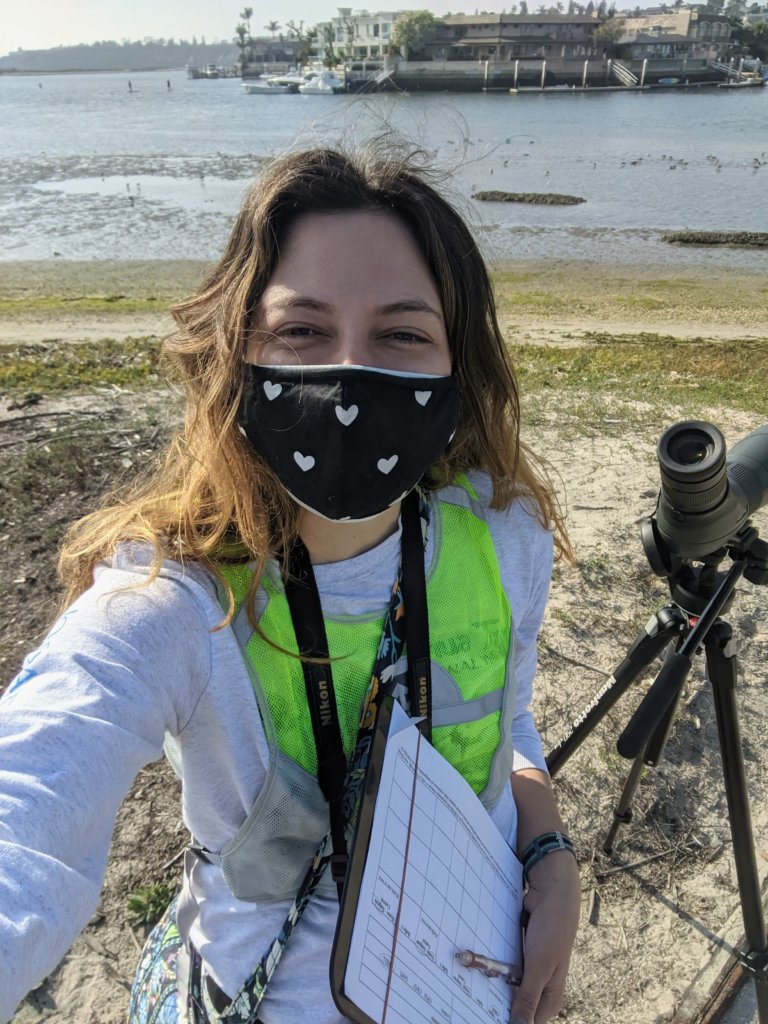
Graduating senior Madison Panzino is passionate about conservation and ecology issues, including protecting shorebirds that live near water along Orange County’s coast.
Panzino, a first generation college graduate who studied ecology and evolutionary biology, conducted undergraduate research as a scholar in Cal State Fullerton’s Southern California Ecosystems Research Program (SCERP). She is among six graduating SCERP scholars, all earning a bachelor’s degree in biological science.
Her study, “Investigating Shorebird Use on Restored Living Shoreline Habitat in Newport Bay, focused on 28 shorebird species present in Newport Bay, such as the Western sandpiper, willet, marbled godwit and least sandpiper.
She worked under the mentorship of award-winning faculty members William “Bill” Hoese, the university’s 2021 Outstanding Professor, and Danielle Zacherl, the 2021 recipient of the Carol Barnes Excellence in Teaching Award, both professors of biological science.
Panzino, who is graduating summa cum laude with a 4.0 GPA, begins a yearlong internship in July with the U.S. Geological Survey’s Earthquake Science Center in Menlo Park. Her project will focus on assessing the effects of natural hazards and climate change on coastal ecology. Due to the pandemic, she will work remotely until the offices in Menlo Park reopen. She plans a career in research.
She will participate in the university’s commencement celebration June 13 at the College of Natural Sciences and Mathematics in-person stage walk.
What was the focus of your research project?

In 2016, several experimental living shoreline plots were established by Dr. Zacherl and a team at Orange County Coast Keeper in Upper Newport Bay. The living shoreline that was installed was an assemblage of native Olympia oysters and eelgrass beds. My research investigated how shorebirds used this living shoreline habitat. I explored if, and how, shorebird use differs between restored living shoreline plots and unrestored mudflat plots. Although this system is dynamic and challenging to describe, I found that shorebirds utilized all types of habitat, such as oyster, eelgrass and mudflats, with different species utilizing different habitats.
Why is this research important?
My research has implications for shorebird management and conservation. We already know that living shorelines are helpful for reducing coastline erosion and increasing diversity, but little work has been done to investigate how these restorations impact shorebirds in this area and their ability to access food. My research findings help demonstrate that all habitat types — oyster beds, eelgrass beds and mudflats — are needed in order to promote the highest richness of shorebirds.
What was fascinating about the research?
I have a fondness for both birds and marine systems and this project blended those two interests. I am also passionate about wildlife management and conservation and I hoped this research would provide important implications for shorebird management and conservation.
How did the pandemic affect your research efforts?
I wanted a project that would allow me to be in the field observing birds. I was fortunate to participate in about 40 days of fieldwork between the months of November 2020 through this March. I, along with Dr. Hoese and other students in the lab, conducted bird surveys at the living shoreline sites, while observing COVID-19 protocols to keep us safe.
How did SCERP help you advance your educational goals?
This program allowed me to design a research project that was closely aligned with my career interests in conservation and management. It was a unique and valuable experience to design and execute my own research project because it gave me a taste of what a career as a researcher would be like. My faculty mentors, Dr. Hoese and Dr. Zacherl, were both helpful and encouraging mentors. Despite their busy schedules, I had weekly meetings with them where they guided, encouraged and challenged me.